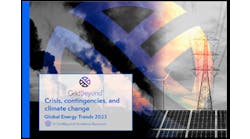REV is in the Air. And the Microgrid Industry is Feeling the Love, Mostly.
This month marks three years since New York began an industry-staggering move to decentralize the electric grid. For the microgrid industry, the policy — known as Reforming the Energy Vision (REV) — unlocked a host of new business possibilities.
The scope of those opportunities – and the forces that still hinder them – became apparent this week as more than 100 microgrid insiders gathered in Washington, D.C. They were there to educate lawmakers about the technology and to powwow about the industry’s future.
Called “Microgrids: Transforming the Grid,” the event represented a kind of coming-of-age for the microgrid industry, a coalescing of resources into political clout in the rough-and-tumble regulatory and policy arenas that heavily influence energy markets.
Conference host, the Microgrid Resources Coalition, seeks to gain new political currency now that it’s part of the larger and more established International District Energy Association (IDEA). The two-year-old MRC merged into IDEA in May.
A common theme emerged out of the series of panel discussions held December 6-7.
First, REV-like policies envisioned by New York and other states are spurring microgrid development. Indeed, the young industry already has drawn influential players, technology companies like ABB, GE, Hitachi, S&C Electric, Siemens, and Schneider Electric and utilities like American Electric Power, Duke Energy and Exelon
But REV-like change isn’t happening fast enough. The microgrid industry is growing. Government policy has not kept up.
“We now have technology that has significantly overclocked the tariff and regulatory frameworks in place,” said Chris Berendt, a partner with Drinker Biddle & Reath and MRC counsel.
Confusion over the utility’s role sits at the heart of the problem. States continue to dictate that utilities operate under rules set decades before microgrids, solar and other forms of distributed energy were even contemplated. Existing rules serve a centralized grid where utilities make their money selling electricity. As more customers use distributed energy, they buy less electricity from the utility. Several panelists pointed out this makes utilities naturally wary of the rise of distributed energy.
“If they view you as a threat, I think it’s because the rules don’t allow them to treat you as a partner,” said Rob Thornton, IDEA president and CEO. “How do we change that paradigm?”
The REV-world envisions a whole new role for utilities, a different way for them to earn revenue. Rather than supply electricity — or earn a return from buildng infrastructure — they would provide a service. They would act as the conductor of the orchestra of resources on the grid.
Write the sheet music
“We have to write the sheet music for this orchestra,” Thornton said.
Or as Joe Sullivan, vice president of Concord Engineering put it, “Where the rubber hits the road is rate design.”
Redefining utility rate design is not easy. Utilities have operated under the same construct for about 100 years. And since utilities are regulated on the state level, rate redesign is a 50-state task.
The complexity of microgrids both confounds and bolsters rate redesign. Microgrids are an intelligent form of distributed energy that offer a host of benefits to the grid – electric and thermal energy, demand response, balancing of renewables, ancillary services.
They are, in fact, “unprecedented tools” for the grid, resources that are “different, higher performing, more dynamic, more flexible than we have ever seen before,” Berendt said.
The trick is determining the cost and benefit of these services to all of the parties, including microgrid customers, utilities and the grid.
Read the related story: Microgrid Advocates Explain Technology’s Advantages to Congressional Leaders
Eric Ackerman, director of alternative regulation for the Edison Electric Institute, urged the microgrid industry to communicate with utilities. He pointed out that the utility distribution system is changing fast, spending about $32 billion this year on grid modernization.
“The distribution grid is going to get smarter,” he said. “There is a whole new kind of planning coming into the utility industry. It is a systems analysis approach…an introduction and application of modernization technology.”
As these changes occur, microgrid developers need to be part of the utility planning process, he said. And they need to help utilities gain adequate insight and visibility into their activities on the grid.
“If you are planning something new, talk to the utility, tell them what you are planning, give them as much notice as possible. If it’s a microgrid application, can it be configured so that there are parts the utility can actually own or participate in.”
Plan the menu
While regulatory change may be difficult and slow, it is happening. “REV is in the air,” said Frank Norcross, vice president of Hudson-Yards Energy, which is developing a microgrid in New York City.
Norcross said the local utility, Consolidated Edison, is proving to be a “good partner” in the microgrid project.
“If you can find ways for the utilities to leverage their experience, their expertise on the distribution network in order to increase their revenue, then you are not just playing a zero-sum game,” he said. “All of our success has been in trying to treat the utilities as partner, trying to meet them on a level field.”
Thornton describe a “fulcrum shift” in the utility/microgrid relationship. But he added that the microgrid industry needs to think more “collectively” to continue the progress.
“Somewhere we are resonating. The question is how do we move this train up the hill?” Thornton said.
Panelists emphasized that it is not easy achieving regulatory change in the energy arena. Regulations drive markets. So jockeying among industries can be fierce.
As summed up by C. Baird Brown, who is MRC counsel and with Drinker Biddle & Reath: “If you don’t plan the menu, you’ll be on it.”
Join Microgrid Knowledge, the IDEA, MRC and executives from utilities, developers and customers from around the world who are interested in microgrid adoption at the Microgrid 2017 Conference and Exhibition on November 6 – 8, 2017 in Boston, Massachusetts. Click here for details.







